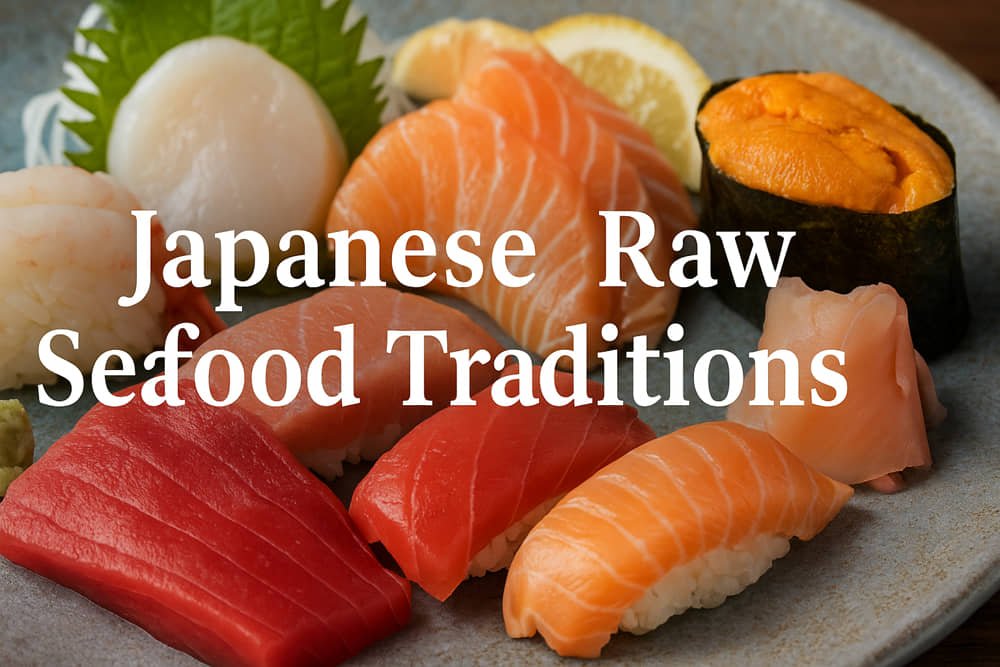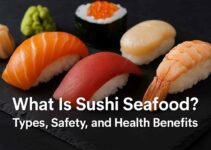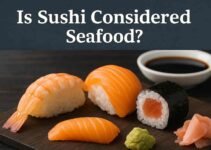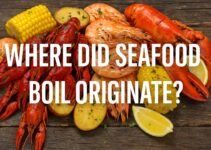Japanese cuisine is globally renowned for its raw seafood traditions, which are rooted in centuries of culinary refinement, environmental adaptation, and cultural philosophy. Unlike other cultures where raw food is limited to niche consumption, Japan has established an entire gastronomic ecosystem around sashimi, sushi, and other uncooked seafood dishes. This isn’t just about taste—it’s about preserving natural texture, respecting seasonality, and emphasizing freshness. With over 6,800 islands and access to both warm and cold ocean currents, Japan benefits from year-round seafood variety. This article explains why raw seafood is so culturally important in Japan, what species are most commonly consumed, and how safety is ensured through meticulous handling and centuries-old techniques.
Contents
- 1 Why Do the Japanese Eat So Much Raw Seafood?
- 2 What Types of Raw Seafood Are Commonly Used in Japanese Tradition?
- 3 Is It Safe to Eat Raw Seafood in Japan?
- 4 What Preparation Techniques Ensure Raw Seafood Safety in Japan?
- 5 Which Regions in Japan Are Known for Raw Seafood Specialties?
- 6 During What Occasions Do the Japanese Serve Raw Seafood?
- 7 How Should You Properly Eat Sashimi and Sushi Like the Japanese?
- 8 How Has Japanese Raw Seafood Culture Influenced the World?
- 9 What Are Common Misconceptions About Raw Seafood in Japanese Cuisine?
- 10 What Are Common Misconceptions About Raw Seafood in Japanese Cuisine?
- 11 Japan’s Raw Seafood Traditions Continue to Evolve with Global Influence
Why Do the Japanese Eat So Much Raw Seafood?
The Japanese consume high volumes of raw seafood due to cultural traditions, geographical advantages, and preservation of freshness through minimal processing.
Japan is surrounded by the sea on all sides and has over 29,000 kilometers of coastline, allowing for direct access to fresh catches daily. This proximity supports a diet where raw consumption is not only practical but optimal. The cultural philosophy of “shun”—eating ingredients at their seasonal peak—promotes consuming seafood raw when it’s at its freshest. Additionally, the tradition of Washoku, recognized as UNESCO Intangible Cultural Heritage, encourages natural presentation and minimal interference with ingredients. Raw seafood aligns perfectly with these values.
How Do Japan’s Geography and Climate Influence Its Raw Seafood Culture?
Japan’s geography ensures consistent access to diverse marine ecosystems that supply sashimi-grade seafood year-round.
The convergence of the Kuroshio (warm) and Oyashio (cold) currents creates rich fishing grounds near Japan’s coastlines. As a result, species such as tuna, mackerel, and squid are available in peak condition across different seasons. Inland seafood markets like Toyosu in Tokyo distribute fresh catch within hours, preserving the integrity of the seafood without freezing. This infrastructure enables daily access to safe, high-quality raw fish in every region.
What Is the Role of “Shun” in Promoting Raw Consumption?
“Shun” is the Japanese principle of eating food at its seasonal best, which directly supports the consumption of raw seafood when its flavor and texture are optimal.
For instance, buri (yellowtail) is best eaten raw in winter, while aji (horse mackerel) peaks in summer. These seasonal windows are widely respected and form the basis of chef selection in omakase meals. Serving raw seafood only at its shun period ensures it is naturally flavorful, reducing the need for sauces or cooking to enhance taste.
How Does Washoku Encourage Raw Seafood Preparation?
Washoku emphasizes balance, simplicity, and ingredient respect—all of which are fulfilled through raw seafood preparation.
A typical Japanese meal strives to highlight natural flavors through raw, steamed, grilled, and simmered dishes. Raw items like sashimi serve as a contrast in both texture and temperature. Moreover, visual presentation and harmony with seasonal elements make raw seafood ideal for expressing Washoku’s core principles.
What Types of Raw Seafood Are Commonly Used in Japanese Tradition?
Japanese raw seafood dishes feature over 15 species regularly, including tuna, salmon, scallops, sea urchin, and squid.
Each species is selected for its specific texture, fat content, and seasonality. Rather than generalize by “raw fish,” Japanese cuisine distinguishes carefully between types of seafood and preparation methods. For example, the texture of raw scallop (hotate) is smooth and sweet, while lean tuna (akami) is more robust and clean.
What Types of Fish Are Used for Sashimi, and How Are They Served?
Sashimi commonly uses tuna, yellowtail, salmon, sea bream, and mackerel, each sliced based on grain direction and fat distribution.
Tuna (maguro) is the most prestigious, often served in three forms: akami (lean), chutoro (medium-fatty), and otoro (fatty belly). Yellowtail (hamachi) is buttery and mild, typically enjoyed during the winter months. Fish like mackerel (saba) require light curing in vinegar due to their strong flavor and parasite risk. Chefs use yanagiba knives to create precise cuts that enhance mouthfeel without damaging muscle fibers.
Is Sea Urchin (Uni) Considered a Popular Raw Item?
Uni is a prized raw delicacy in Japan, known for its creamy texture and ocean-sweet flavor.
Harvested from the gonads of sea urchins, uni is served fresh and never cooked. Hokkaido supplies over 80% of Japan’s domestic uni, particularly during summer months when its flavor peaks. Premium-grade uni is bright orange, firm, and packed in wooden trays called “hako-uni” to maintain its shape and taste during transport. It’s commonly served atop sushi rice or as sashimi.
What Are Some Lesser-Known Raw Seafood Items in Japanese Cuisine?
Other raw items include ika somen (squid cut into noodle-like strips), amaebi (sweet shrimp), and katsuo (bonito).
Ika somen is a specialty of Kyushu, offering a clean bite and subtle sweetness. Amaebi is typically served raw with the head deep-fried and plated together. Katsuo, often served as tataki (seared outside, raw inside), is an example of regional raw preparation that blends traditional and modern techniques. These lesser-known options reflect local preferences and expand beyond the standard sushi offerings.
Is It Safe to Eat Raw Seafood in Japan?
Raw seafood in Japan is safe due to strict hygiene protocols, cold-chain logistics, and national food safety regulations.
Japan has some of the world’s most advanced food safety systems for seafood, particularly at auction markets and high-end restaurants. Every step—from catch to serving—follows temperature control, visual inspection, and parasite mitigation methods.
How Does Japan Maintain Hygiene and Storage Standards for Raw Seafood?
Japan enforces regulated cold-chain storage, flash freezing where necessary, and direct-from-source delivery within 24 hours.
Fishing vessels immediately store catch in ice or use on-boat refrigeration. Markets like Toyosu conduct sanitation checks and UV sterilization to reduce bacterial contamination. Restaurants receive fish within hours and often prepare it the same day, following HACCP-like systems adapted for raw seafood use.
How Do Japan’s Safety Standards Compare to Other Countries?
Japan’s raw seafood safety standards are stricter and more comprehensive than those in most Western countries.
The Ministry of Health, Labour and Welfare outlines specific microbiological limits for raw seafood, mandating freezing for certain species and requiring records of origin and handling. In contrast, many countries lack distinct raw seafood safety protocols. For example, the U.S. FDA requires freezing for parasite mitigation, but Japan complements that with supply chain visibility and chef training.
Why Do Sashimi and Sushi Rarely Cause Food Poisoning in Japan?
Cases of foodborne illness from raw seafood are rare in Japan due to species selection, chef skill, and parasite prevention.
Chefs are trained to avoid high-risk fish like wild-caught salmon unless flash frozen. Parasites such as anisakis are eliminated through freezing or choosing farmed varieties. Additionally, Japanese diners consume raw seafood fresh, often within 48 hours of catch, reducing bacterial growth risk significantly.
What Preparation Techniques Ensure Raw Seafood Safety in Japan?
Raw seafood safety in Japan is maintained through precise techniques such as ikejime, cold-chain logistics, and specialized knife skills.
These methods not only preserve the freshness and texture of the seafood but also prevent bacterial growth and enzymatic degradation. The procedures are standardized across high-end restaurants and fish markets.
What Is the Role of Ikejime in Handling Live Fish?
Ikejime is a Japanese method of fish slaughter that minimizes stress and preserves quality by disabling the brain and spinal cord immediately after capture.
This technique reduces lactic acid buildup and inhibits the growth of spoilage bacteria. The process includes inserting a spike into the fish’s brain, severing the spinal cord, and draining blood quickly. Fish treated with ikejime have firmer flesh, longer shelf life, and better flavor retention when served raw.
How Do Japanese Chefs Use Filleting and Refrigeration to Ensure Freshness?
Chefs use single-direction filleting techniques and immediate refrigeration to prevent contamination and oxidation.
After removing viscera, fish are rinsed with cold water or diluted sake to eliminate surface bacteria. Fillets are then wrapped in moisture-absorbing paper and stored at temperatures between 0–4°C. Timing is critical: sashimi is often prepared within 12–24 hours post-processing, depending on the species.
Why Are Specialized Knives Essential in Preparing Raw Seafood?
Yanagiba knives are essential for slicing sashimi because they produce clean, single-stroke cuts that prevent cell damage.
A dull or improperly angled knife can crush the flesh, causing oxidation and bacterial spread. Japanese chefs train for years to master knife handling, using precise angles and draw cuts to maintain both hygiene and presentation. The long, slender blade of the yanagiba allows uninterrupted cuts that retain moisture and structure.
Which Regions in Japan Are Known for Raw Seafood Specialties?
Several Japanese regions—especially Hokkaido, Kyushu, and the Kanto area—are recognized for their raw seafood traditions and unique specialties.
Geographical location influences available species, seasonal access, and local preparation styles. These areas serve as both production hubs and cultural centers for raw seafood excellence.
What Types of Raw Seafood Come from Hokkaido?
Hokkaido is famous for cold-water sashimi like scallops (hotate), sea urchin (uni), and ikura (salmon roe).
The colder waters around Hokkaido enhance fat content and sweetness in seafood. Uni from Rishiri and Rebun islands is among the most sought-after in Japan. Scallops are often served raw with ponzu sauce or wasabi soy. Ikura, although cured, is eaten raw and considered a regional delicacy in winter months.
What Role Does Toyosu Market Play in the Raw Seafood Industry?
Toyosu Market in Tokyo is Japan’s largest seafood auction hub, distributing premium raw fish to restaurants nationwide.
Opened in 2018 to replace the historic Tsukiji Market, Toyosu features advanced cold storage, sanitation controls, and digital traceability systems. Each day, over 400 seafood species are sold, including live tuna for high-end sashimi. Tours and tuna auctions are open to the public, reinforcing transparency and culinary education.
What Unique Raw Seafood Dishes Are Found in Kyushu?
Kyushu is known for regional raw dishes like ika sashimi, kibinago (silver-stripe round herring), and fugu (pufferfish).
Ika is often served while still moving, known as odori-don (dancing squid). Kibinago is flash-sliced and arranged in fan-like presentations. Fugu is a licensed specialty due to its potential toxicity; chefs must undergo rigorous certification to prepare it raw as fugu sashimi (usuzukuri). These dishes reflect local biodiversity and centuries of culinary refinement.
During What Occasions Do the Japanese Serve Raw Seafood?
Raw seafood is served during cultural ceremonies, family gatherings, religious festivals, and formal dining experiences like omakase.
Its presence signals respect for guests, seasonal awareness, and commitment to culinary craftsmanship. These traditions have been preserved for generations and are deeply embedded in the Japanese social fabric.
How Is Sashimi Incorporated into Japanese Celebrations?
Sashimi is served during New Year (osechi ryori), weddings, and seasonal festivals to symbolize freshness, purity, and prosperity.
In osechi boxes, sashimi-grade shrimp and fish slices are chosen for color and symbolism. At weddings, whole fish (tai) sashimi is offered to represent luck and longevity. During Setsubun, raw sardines may be served with soy and ginger to ward off evil spirits.
Why Is Raw Seafood Important in Omakase and Sumo Culture?
In omakase dining, raw seafood represents trust between diner and chef, while in sumo traditions, it reflects high-protein, clean-eating culture.
Omakase (“I leave it up to you”) features sashimi as a core component, often highlighting the chef’s skill in sourcing and preparing raw items. Sumo wrestlers consume raw fish for its digestibility and muscle recovery benefits, especially in off-season training periods.
How Should You Properly Eat Sashimi and Sushi Like the Japanese?
Eating raw seafood properly in Japan involves specific etiquette for dipping sauces, ingredient order, and regional differences in preparation.
This culinary behavior is not just tradition—it ensures optimal flavor, respects the chef’s intent, and enhances the dining experience. From how to use wasabi to the sequence of tasting, every detail matters in authentic Japanese dining.
How Should You Use Wasabi, Soy Sauce, and Pickled Ginger?
Wasabi should be lightly dabbed on fish, soy sauce should touch only the fish (not rice), and pickled ginger is used to cleanse the palate between bites.
When eating sashimi, wasabi is placed directly on the fish, not mixed into soy sauce. For sushi, especially nigiri, dipping should be fish-side down to avoid soaking the rice and disrupting texture. Pickled ginger (gari) is not a topping; it’s meant to refresh the palate when switching between types of fish.
What Is the Difference Between Edomae Sushi and Other Regional Styles?
Edomae sushi from Tokyo uses vinegared rice and preservation methods, while regional styles vary by ingredient and technique.
Edomae sushi developed during the Edo period emphasizes simplicity, often using aged or cured fish like anago (sea eel) and kohada (gizzard shad). In contrast, Kansai-style sushi (oshizushi) involves pressed sushi, and Hokkaido sushi features more fresh, raw seafood with less seasoning. These variations reflect ingredient availability and cultural preferences across regions.
What Is the Recommended Order for Eating Sashimi or Sushi?
The ideal sequence starts with light-tasting white fish, followed by medium-fat fish, and ends with rich, fatty varieties.
For example, a progression may begin with tai (sea bream), then move to buri (yellowtail), and conclude with otoro (fatty tuna belly). This order allows the palate to gradually adjust to stronger flavors and appreciate nuances without being overwhelmed.
How Has Japanese Raw Seafood Culture Influenced the World?
Japanese raw seafood culture has shaped global dining by introducing sushi bars, omakase dining, and high-grade seafood standards in over 100 countries.
It has also influenced how other cultures perceive freshness, food aesthetics, and food safety. Japanese methods have become benchmarks in the culinary world for handling and presenting raw fish.
How Did Sushi and Sashimi Expand Into Western Dining?
Sushi entered Western markets in the 1960s via Los Angeles and New York, evolving into mainstream cuisine by the 1990s.
The California Roll was one of the first Americanized versions, substituting raw fish with crab and avocado. From there, authentic sushi restaurants grew in popularity, followed by sashimi platters and omakase menus. Today, Japan exports sushi-grade fish globally, and chefs worldwide train in Japanese techniques.
Which Countries Have Adopted the Toyosu Market Model?
Countries like Singapore, Norway, and the U.S. have developed centralized seafood markets inspired by Toyosu’s auction, hygiene, and traceability standards.
Singapore’s Jurong Fishery Port, for instance, models its auction and sanitation protocols after Toyosu. Norway’s salmon industry has collaborated with Japanese buyers to implement similar freshness and grading systems. In the U.S., premium restaurants increasingly source fish via suppliers who mimic Toyosu’s cold-chain logistics and auction transparency.
How Has Japan Defined the Global Standard for “Sushi-Grade” Fish?
Japan defines “sushi-grade” fish by parasite control, freshness, and visual inspection—standards that are now recognized internationally.
For example, tuna must meet color, fat marbling, and muscle texture criteria. Fish like salmon, when used raw, must be flash-frozen at −20°C for 7 days to eliminate parasites. Japanese authorities and chefs have set these benchmarks, and exporters worldwide now label their products accordingly to meet consumer expectations.
What Are Common Misconceptions About Raw Seafood in Japanese Cuisine?
Common myths include assuming all raw fish is sashimi, that any raw fish is safe, or that sushi is an ancient Japanese invention.
Clarifying these misconceptions helps improve public understanding and respect for Japanese culinary precision. Misinformation can lead to unsafe preparation or cultural misunderstanding.
Is It True That All Raw Fish Is Considered Sashimi?
No, sashimi refers specifically to sliced raw seafood served without rice, and not all raw fish qualifies.
To be classified as sashimi, fish must meet hygiene, texture, and visual standards. For example, fatty fish like salmon must be frozen to eliminate parasites before being used. Additionally, seafood like octopus may be lightly boiled before being served as “sashimi” due to texture considerations. The term is technical, not generic.
What Are Common Misconceptions About Raw Seafood in Japanese Cuisine?
Several widespread misconceptions distort public understanding of how raw seafood is used in Japan, including generalizations about sashimi, safety, and historical origins.
Correcting these misunderstandings is essential for accurate cultural appreciation and for preventing unsafe imitation of Japanese culinary practices.
Is It True That All Raw Fish Is Considered Sashimi?
No, sashimi refers specifically to carefully sliced raw seafood served without rice, and not all raw fish qualifies.
Only seafood that meets freshness, texture, and safety criteria can be used for sashimi. For example, raw freshwater fish are generally excluded due to parasite risks. Sashimi also requires precise knife cuts and specific serving styles—thin, clean slices arranged aesthetically on a plate.
Can Any Raw Fish Be Safely Eaten?
No, only species that have been properly handled, stored, and, if necessary, frozen can be safely eaten raw.
Wild-caught salmon, for instance, contains parasites and must be flash-frozen at −20°C for 7 days before consumption. Fish like escolar or pufferfish require licensed preparation. Assuming any raw fish is safe to eat increases the risk of foodborne illness.
Is Sushi a Traditional Japanese Dish from Ancient Times?
No, modern sushi evolved during the Edo period (1603–1868) and was not part of ancient Japanese cuisine.
While early forms of fermented fish over rice existed as early as the 8th century (narezushi), the hand-formed nigiri sushi we know today originated in Tokyo as a form of fast food. It was only in the 20th century that sushi became a refined, globally exported cuisine.
Japan’s Raw Seafood Traditions Continue to Evolve with Global Influence
Japan’s raw seafood culture is both rooted in centuries of tradition and constantly evolving through international exchange, advanced safety standards, and culinary innovation. From ikejime on fishing boats to omakase counters in Tokyo and Michelin-starred sushi restaurants abroad, the practices around raw seafood in Japan have become a global benchmark for quality and artistry. As global interest continues to grow, understanding the nuances—including safety practices, regional varieties, and cultural meaning—is essential for appreciating this culinary tradition authentically.
For deeper insights into how raw seafood is classified and regulated, explore our article on How Sushi-Grade Fish Is Classified. If you’re curious about safety protocols beyond Japan, read Is It Safe to Eat Raw Seafood? for a global comparison.



